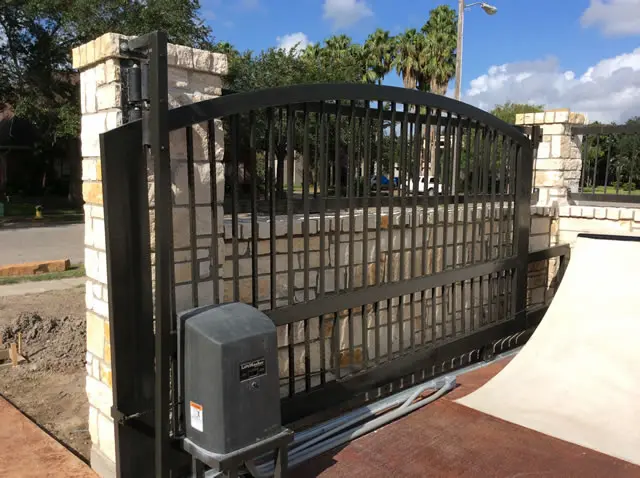![The Great Fence Debate Wood Versus Vinyl [How to Choose]](https://www.dcfence.com/wp-content/uploads/2024/04/The-Great-Fence-Debate-Wood-Versus-Vinyl-How-to-Choose-300x157.webp)
The Great Fence Debate: Wood Versus Vinyl [How to Choose?]
When it comes to enhancing the privacy, security, and aesthetic appeal of your home, few elements play as pivotal a role as your choice of

Ensuring the safety and security of our surroundings has become more crucial than ever. Security entrance gates are vital in controlling access to various premises, providing a reliable and efficient solution.
We will explore the different types of security entrance gates available, discuss their key features, and highlight their benefits to businesses and individuals. Whether you’re a facility manager, a homeowner, or someone interested in enhancing security measures, this guide will equip you with the essential knowledge to make informed decisions.
Security entrance gates are physical barriers integrated with access control systems to regulate access to premises. They ensure that only authorized personnel can enter while preventing unauthorized entry. These gates consist of key components like sensors, motors, control panels, and locking mechanisms, all working together to provide secure and controlled entry.
By integrating with access control systems, security entrance gates enhance security measures, enable efficient management of user credentials, and offer centralized control over entry points. They are essential for various applications, from commercial buildings to residential complexes, ensuring safety and streamlined access management.
Turnstile gates are a popular type of security entrance gate used to control pedestrian access. Optical turnstiles employ infrared sensors to detect individuals passing through, allowing smooth and hands-free operation. As the name suggests, full-height turnstiles are taller and provide a more robust barrier, ideal for high-security environments. With their three rotating arms, tripod turnstiles offer a balance between security and user throughput.
These turnstile gates offer numerous benefits, such as enhanced security, efficient crowd management, and accurate people counting. They find applications in various settings, including stadiums, transportation hubs, office buildings, and leisure facilities.
Swing gates are versatile security entrance gates that operate by swinging open and closed. Single swing gates consist of a single panel that pivots on one side, while double swing gates have two panels that swing open from the middle. Bi-folding swing gates feature multiple panels that fold together when opening and provide a compact footprint. These gates offer several notable features, including customizable designs, robust construction, and automation and access control integration options.
Swing gates provide advantages such as ease of installation, suitability for various entry widths, and the ability to match aesthetic requirements. They are commonly used in residential properties, commercial complexes, and industrial sites, providing security and a visually appealing entrance solution.
Single sliding gates consist of a single panel that slides to one side, while telescopic sliding gates have multiple panels that overlap and retract to create a compact opening. Cantilever sliding gates are designed without a track on the ground, utilizing a counterbalance system for smooth operation. Factors such as available space, terrain, and security requirements need to be considered when considering sliding gates.
Additionally, operational considerations like gate speed, safety features, and power source should be evaluated to ensure optimal performance. Sliding gates offer a practical solution for properties with limited space or uneven terrain, and they are commonly utilized in residential areas, commercial properties, and industrial facilities.
Barrier arm gates, also known as boom barrier gates, are security entrance gates that utilize a horizontal arm to control vehicular access. Boom barrier gates consist of a sturdy arm that can be raised or lowered to allow or restrict vehicle passage. Drop arm gates feature a vertical arm that drops down to prevent access. On the other hand, swing arm gates have a pivoting arm that swings open and closes.
These barrier arm gates are commonly deployed in various scenarios, such as parking lots, toll booths, and vehicle entrances of gated communities. They provide efficient and reliable vehicle access control, ensuring proper authorization and enhancing security.
Optical speed gates utilize infrared sensors to detect individuals passing through, allowing for seamless and hands-free operation. Motorized speed gates feature automated panels that open and close swiftly, ensuring efficient traffic flow. Speed gate technology advancements have improved reliability, durability, and user experience.
Additionally, speed gates can be integrated with facial recognition systems, allowing for enhanced security and accurate identification of individuals. These modernized speed gates find applications in various settings, including airports, train stations, office buildings, and public facilities, where high throughput and strict access control are crucial.
Revolving doors are a popular type of security entrance gate known for their controlled access and energy efficiency. Classic revolving doors feature rotating wings within a circular enclosure, offering smooth and continuous pedestrian movement. Security revolving doors incorporate features like anti-tailgating sensors and integrated access control systems.
Combination systems combine revolving doors with other gate types to meet specific security requirements. These doors often include advanced access control features such as biometric authentication and card readers, making them suitable for commercial buildings and high-security facilities.
Security portals are advanced entrance gate systems that enhance safety and prevent unauthorized access. Mantrap portals provide controlled entry by allowing only one person at a time, while airlock portals create an intermediate space to minimize the risk of unauthorized access.
These portals incorporate advanced screening technologies such as metal detectors and biometric authentication. They are built to comply with high-security standards and find applications in government buildings, airports, and other sensitive environments requiring stringent access control measures.
Vehicle gates are crucial for controlling vehicle access in security entrance systems. Sliding and swing gates provide horizontal or swinging movement options to allow or restrict vehicle entry. Bollards and rising curbs are physical barriers that can be raised or lowered.
These gates are often integrated with vehicle identification systems for authorized access control. They find applications in various settings, from residential complexes to commercial properties, ensuring effective regulation and security for vehicular traffic.
Hybrid solutions in security entrance gates involve integrating different gate types and technologies to create customized solutions for specific requirements. This approach combines the benefits of physical barriers with access control gates, such as integrated gate and fence systems for perimeter protection. Hybrid solutions can be tailored to accommodate larger vehicles, wheelchair accessibility, or specific security protocols.
Additionally, hybrid configurations can combine gate types, such as integrating gates with turnstiles, to optimize the flow of pedestrian and vehicle traffic. These flexible and versatile solutions offer a comprehensive approach to address unique security needs.
Choosing the right security entrance gate requires careful consideration of various factors. These include assessing security needs, considering space constraints, evaluating budget and maintenance factors, and considering aesthetics and user experience. By thoroughly considering these aspects, one can make an informed decision to select a security entrance gate that effectively aligns with their specific requirements.
Proper installation and maintenance are essential for security entrance gates. Site preparation ensures a suitable foundation and necessary infrastructure. Following professional installation guidelines provides correct assembly and programming. Routine maintenance, including inspections, cleaning, and testing, helps keep the gate in optimal condition. Troubleshooting common issues resolves any problems. Adhering to these practices ensures reliable and effective performance of the security entrance gate over time.
Compliance with regulations and standards is crucial when implementing security entrance gates. It includes adhering to industry-specific security standards and certifications, ensuring ADA compliance for accessibility, and following fire and emergency regulations. By meeting these compliance requirements, businesses and organizations can ensure the safety, accessibility, and legal compliance of their security entrance gates.
Security entrance gates offer enhanced security and access control, serving as a deterrent to unauthorized entry. They streamline visitor management processes and provide data and analytics for improved operations. These gates ensure that only authorized individuals can access the premises and collect valuable information on visitor traffic, helping businesses make informed decisions regarding security protocols and resource allocation.
Corporate offices often utilize security entrance gates to control access to their premises, ensuring the safety of employees and sensitive information. Airports and transportation hubs rely on these gates to manage the flow of passengers, enhance security measures, and streamline boarding processes.
Government and public facilities implement security entrance gates to protect critical infrastructure and regulate access to restricted areas. Educational institutions also use these gates to ensure the safety of students and staff while maintaining a secure learning environment. These scenarios highlight the practical application and effectiveness of security entrance gates.
Advancements in biometric authentication, AI and machine learning integration, and the incorporation of smart connectivity and IoT capabilities drive the future of security entrance gates. These innovations enhance access control accuracy, enable adaptive security measures, and facilitate seamless integration with other security devices. The future of security entrance gates promises improved security, efficiency, and a more seamless user experience.
Security entrance gates are essential for controlling access and ensuring safety in various environments. With a wide range of gate types, businesses, and individuals can choose the solution that best suits their needs. These gates offer enhanced security, streamlined access control, and operational efficiency.
To explore further and find the perfect security entrance gate solution for your specific needs, contact D&C Fence Co., a trusted provider with expertise in high-quality security gates and fencing solutions. Contact us today to unlock the potential of advanced security entrance gates and safeguard your premises effectively.
By submitting, you agree to receive emails from Uscreen and to our privacy policy.
![The Great Fence Debate Wood Versus Vinyl [How to Choose]](https://www.dcfence.com/wp-content/uploads/2024/04/The-Great-Fence-Debate-Wood-Versus-Vinyl-How-to-Choose-300x157.webp)
When it comes to enhancing the privacy, security, and aesthetic appeal of your home, few elements play as pivotal a role as your choice of

PVC (Polyvinyl Chloride) fencing is a type of synthetic plastic fence that offers a modern alternative to traditional materials like wood and metal. Distinguished by

Wood fences are one of the most traditional and versatile types of fencing used to delineate property lines, enhance privacy, and contribute to the aesthetic
Complete the form below and a representative will contact you shortly.